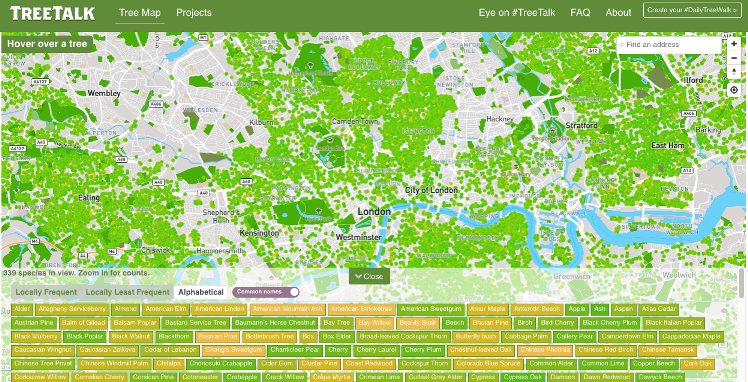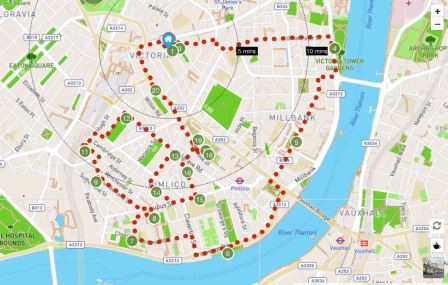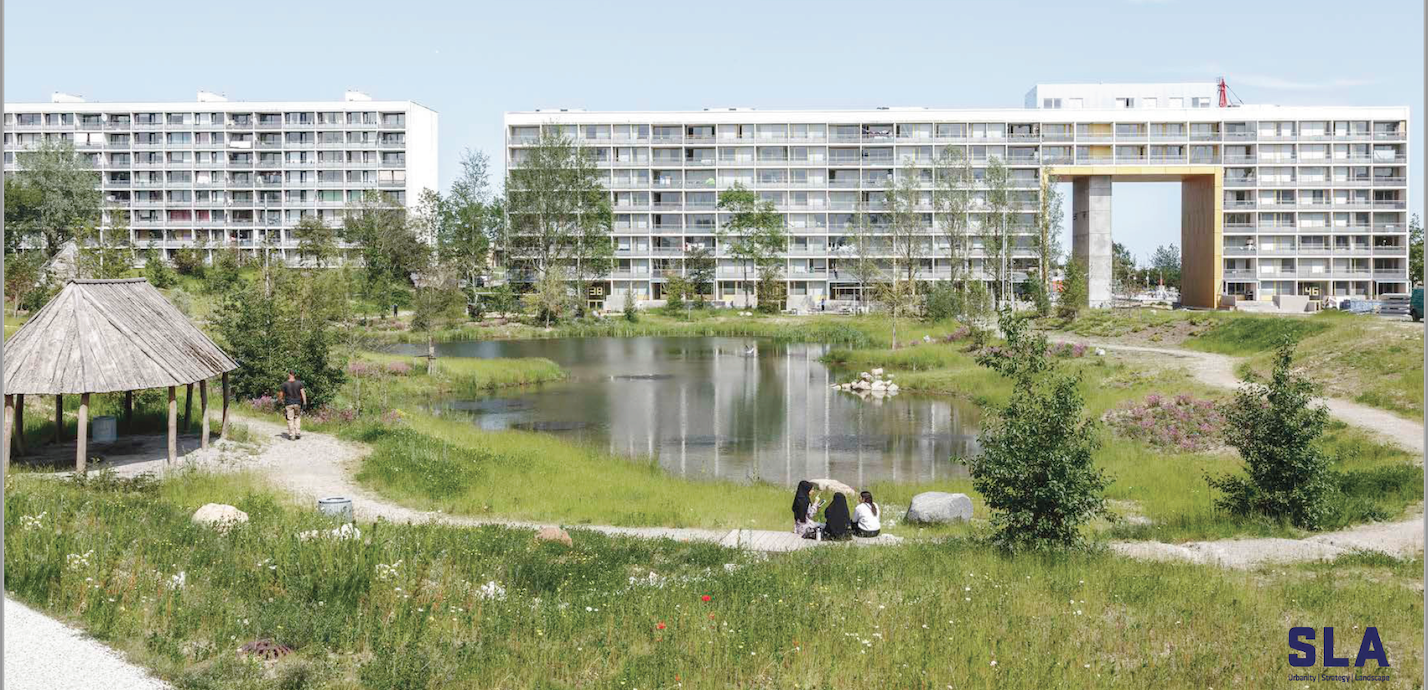Treetalk and Greentalk
Treetalk is an IT application helping people to enjoy trees in their neighbourhood in London. It’s called Treetalk because it hopes to encourage people to talk about and share routes around publicly accessible trees in the city of London.
The TreeTalk site site has mapped more than 700.000 trees in London. During the lock down caused by the Covid-19 pandemic, it experienced a more than fifty-fold increase in visitors. Obviously, this was driven by the fact that people were seeking opportunities to enjoy in new ways the few outdoor walks they were allowed. It resulted in huge traffic spikes which caused the media to get interested which led to additional peaks. The IT application will create a personalised walk to explore trees in a London location and will provide details and pictures (where possible) of the trees on route. It also allows you to explore routes in parts of the city outside of your neighbourhood. Already other cities in the UK and internationally have expressed an interest or are in the process of setting up similar applications for tree or green talks in their cities or local districts. At peaks during Covid 19 lockdown, 30.000 walks were registered in a single day. Today Treetalk is seeing on average 2000 walks being generated in a single day.
Other products based on the same base platform:
- GoParks – web based service which highlights parks with features and allows for separately curated routes around these parks. GoParks London – also a free app – funding from social sector bodies (see below)
- Greentalk – an online, consumer-facing map-based tool enabling users to discover and interact with green infrastructure in a pre-defined area of any size from a city park to a whole country.
Actors
The treetalk, Greentalk and GoParks apps were all created by the Greentalk lab. The lab employs three persons with a mix of programming, data and environmental/nature skills and interests. In order to develop the apps Greentalk Lab have collaborated with
- municipal departments providing the data
- municipal departments having plans to plant and maintain additional trees in their municipality as well as
- departments perhaps wanting to offer ways to explore and create routes around certain cultural points of interest like parks, gardens, trees, artwork or buildings.
For the green talk and GoPark apps. Greentalk lab and especially Municipal departments have also worked with community actors and citizen groups at local level to understand their interests, motivation and likely roles in relation to the general purpose of the municipality. In this way, the municipality found synergies to explore in these two apps.
Financing
The Greentalk lab has partly financed the initial app developments themselves and partly through separate projects like the GoParks project which was financed through different funding programs that the participating organisations applied for. The participating organisations as the Big Green London map consortium comprises: CPRE London, London Friends of Green Spaces Network, Greenspace Information for Greater London, Revolution Consultancy and Design; and National Park City Foundation. Today, most of Greentalk Lab services are offered on a commercial basis.
Source of data
The application uses data released from the Greater London Authority (GLA) https://data.london.gov.uk/dataset/local-authority-maintained-trees. The application would have a long way to go before every tree in London is mapped as there are more than 8 mill. trees in London, but already more than 600 species of trees are registered in the Treetalk application.
The Greentalk app service established in Hounslow Borough required data provision from three different partners to Hounslow authorities. Hounslow has outsourced management of trees to three different plant service companies. One partner for trees in streets, one for trees and plants in parks and the third one for trees and plants in social housing estates. Through these sources Green talk lab has registered trees in Urban woodlands and parks also. In Hounslow borough, this has meant that a further 90000 trees over and above the Treetalk count have been identified now totaling 123000 trees. For woodlands, trees are often registered as groups of same species of trees.
Greentalk Lab uses the tree data released as open data. To present and display the data in an interesting way and encouraging users to conduct walks visiting trees or other points of interest.
When starting there were 700000 trees registered in the streets of London. However, not every borough in London can provide relevant and qualified data on the tree population in their streets. The kind of data quality issues faced was for instance lack of details of correct species, mistakes in terms of Spelling mistakes and incomplete data. The data is also collected in different ways and the work flows of data collectors are mysterious. So GreenTalk Lab has had discussion with boroughs to understand how they collect and how the data is used.
Success factors
As a result of the pandemic, local authorities have come to realise that they need to provide people opportunities to experience their local nature and take an interest in their environment and trees. It is the aim of the city councils to expose the fascinating information in an attractive way to citizens in their communities. It is about communicating the very interesting information about trees incl. what exist in terms of rare trees and blossom experience opportunities, but also what these trees do to add value to the community in terms of improving climate, temperatures, air quality, etc. Obviously, to focus on the communication, dissemination and added value, different departments need to get involved plus external stakeholders in order to mobilise these activities.
With the Hounslow implementation, citizens are offered these services:
- Liking trees
- Tagging individual trees with comments
- Gather modules – embellish trees and provide further description
- Curated route – you devise a route to share with others – look at the map by selecting trees; where you can also describe the route in a narrative.
Diversity/inclusion
Hounslow local authorities, a client of Greentalk lab, wants to develop social cohesion and attract diversity through the involvement and engagement of all citizen group. In doing that, they are also supporting community groups in socially deprived neighbourhoods to take an active role in maintaining trees and plants in their neighbourhoods. They do that by offering them a presence on green talk and a voice in terms of liking, tagging and commenting on trees and routes around their favourite trees.
Business model of Greentalk Lab
The initial Treetalk app is offered as a free app to citizens. It allowed Greentalk Lab to develop the platform and test data quality and functionality with users. With users starting to apply routes using the app further learnings were gathered and ideas started to emerge for the further development of the platform. The Greentalk app service is offered as a license platform to cities. Already cities like Bradford, Hounslow, Manchester are clients of Greentalk Lab.
This means that Treetalk is now available as Greentalk in any city with the functionality that this particular city would like implemented. The Greentalk app can be branded whatever the city would like.
In terms of the Treetalk app, this will remain free for the city of London Apart from introducing the regular GLA up-dates from open data, the functionality is not expected to change.
Green talk offers something beyond what Treetalk is and can do. Basically it can act as a shop window for local authorities
Green talk Lab currently has multiple dialogues with cities in the UK and outside UK. It is also working with the health insurer BUPA to develop a product BUPA provides to business clients to offer their employees an attractive city-walk around their work premises including looking up trees and/or artwork. There is evidence that such city-walks will improve general mental and physical health amongst employees and as such the app would quickly be worth its investment.
Pricing structure for the Green talk app service:
- Starting cost is offered in three tier – a) small city up to 10000 points of interest, b) standard unlimited and c) Standard Pro which also offers social media integration. The costs are 1) initial set up cost and 2) monthly subscription.
- The set up costs vary from 5000-15000 pounds sterling required and the monthly subscriptions between 350 and 900 pounds depending on the size and functionality.
- Obviously, Greentalk Lab will require good quality data and that is not always easy for cities to provide.
Indicators of achievement
- Obviously, for the treetalk app, the key indicators are number of users and number of routes registered and during the lock-down a real increase in app downloads, registrations and routes used.
- For city authorities the key indicators are number of trees adopted by citizens and or local communities. Also, many city authorities are planting new trees as part of the climate adaptation and de-carbonisation strategies.According to Greentalk lab cities are indicating that up to 30% trees planted will fail from not being maintained and watered properly. With the Greentalk app and tree adoption from citizen groups watering and maintaining of trees can be optimized and failure rates can be reduced. Obviously replacement cost of failed trees is high and a reduction to 5-10% will benefit the local authorities.
- Obviously cities need to show what they are doing environmentally and it can be difficult to promote and engage communities in tree and woodland projects. With the Greentalk app, the city authorities can encourage and incentivize communities to adopt and maintain trees and groups of trees or entire parks and hence become a contributor to the local environment.
- Obviously with tree planted and growing it has impacts on carbon storage and air quality improvements.
Transferability to other cities
The Green talk platform allows for adaptation to individual city requirements and has also been adapted to “park talk” as it is shown through the GoParks app service developed in London and it can be adapted to other types of points of interest instead of trees.
Connection with URBiNAT
Many digital apps are being explored in URBiNAT intervention areas, notably with a view to realising the full social, environmental and economic potential of the Nature Based Solutions being implemented. The apps we discuss in this post are of particular interest since:
- Most cities in URBiNAT have an element of tree planting, maintaining and park developments. As an example Høje Taastrup is planning a park to developed where today there is a road and a parking lot.
- Most URBiNAT cities already have a many trees that exist in the healthy corridors being further developed.
- Most URBiNAT cities will be using tree planting and maintaining to address their carbon storage issues towards a cleaner city air and carbon free city by 2050 or earlier.
Greentalk or similar apps are therefore exciting approaches to engaging citizens in this clean air lowering of carbon emission journey, giving them a role to play in making it happen and also offering a way to make hiking a more exciting activity by also offering a knowledge development dimension to the walk.
Further Reading
This article is an extract from URBiNAT Deliverable 3.4. All URBiNAT deliverables can be accessed via the RESOURCES page of this website.






